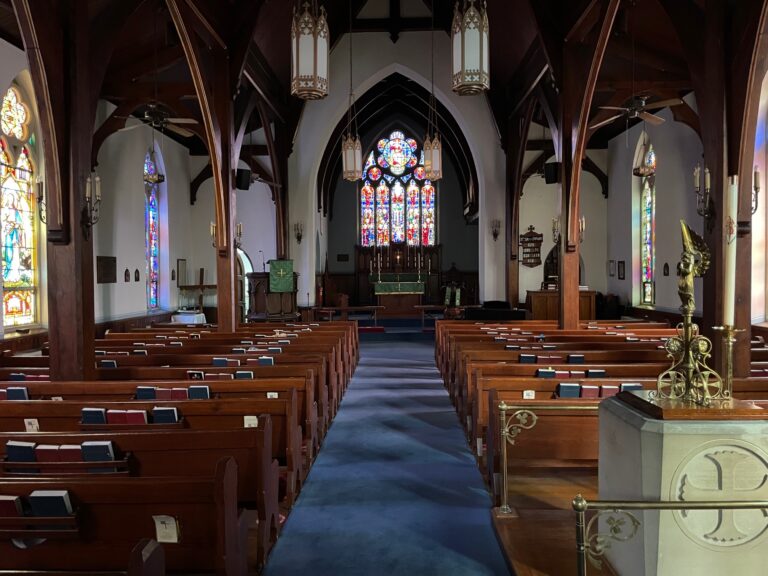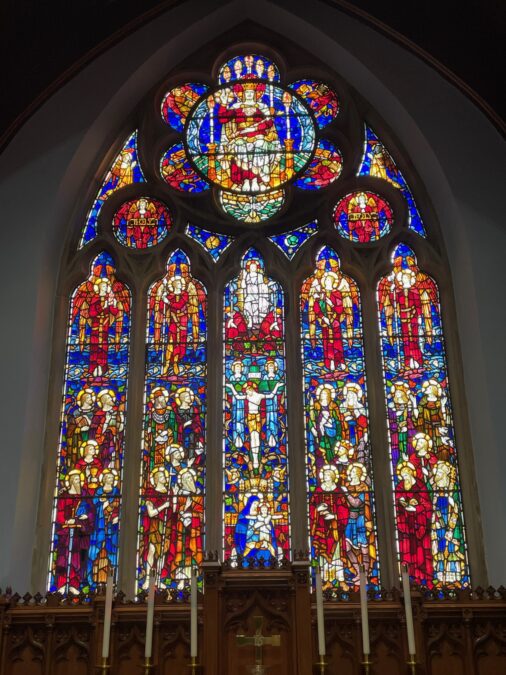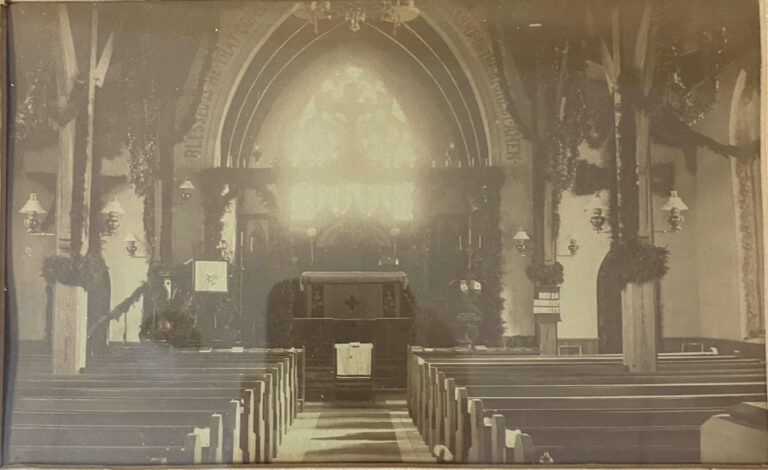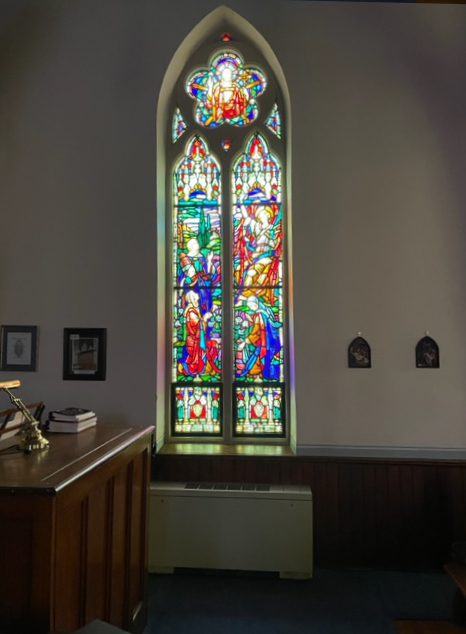Windows of the Chancel and Nave

The Te Deum Window Is At The Back Of Chancel

TE DEUM WINDOW
THE TE DEUM WINDOW
It is called the “Te Deum window” because it is designed upon the great Latin hymn to the Father and Son called Te Deum found on page 95 The Book of Common Prayer. The hymn is sung regularly at Morning Prayer. The Latin phrase Te Deum translates to “You are God.”
Te Deum
You are God, we praise you:
You are the Lord: we acclaim you;
You are the Eternal Father:
All creation worships you.
The sun, moon, and stars in the window are symbols of creation. All creation worships God.
To you all angels, all the powers of heaven,
Cherubim and Seraphim, sing in endless praise:
Holy, holy, holy Lord, God of power and might,
Heaven and earth are full of your glory.
The crucified Christ is flanked by two angels, there are angels kneeling and praying, and singing, “Holy Holy.” There are four large archangels – Michael, Gabriel, Raphael, and Urel. All angels worship God.
The glorious company of apostles praise you.
The notable fellowship of prophets praise you
The white-robed army of martyrs praise you.
Throughout the world the holy church acclaims you.
There are 15 apostles, prophets, and martyrs in the window. Peter holds the keys to the Kingdom. John the gospel writer, clutches the lamb, and John the Baptist is dressed in animal skins. The whole Church worships God.
Father, of majesty unbounded,
Your true and only Son, worthy of all worship
And the Holy Spirit, advocate and guide
The Holy Spirit descends in the form of a dove to be our advocate and guide, to bring the Christ child into the world and to bring the Church into the world at Pentecost.
You, Christ, are the king of glory,
The eternal son of the Father,
When you became man to set us free
You did not shun the Virgin’s womb.
Mary is in the middle of the column at the bottom with the child Jesus standing on her lap with his arms outstretched. Is Jesus reaching out to us, prefiguring his crucifixion, or both?
You overcame the sting of death
And opened the kingdom of heaven to all believers.
The crucified Christ is on the cross. His head is crowned with thorns and nails pierce his hands and feet. Above the crucified Christ is the risen Christ, stepping out of the tomb between the sleeping soldiers. His hands and feet show his wounds. His right hand is raised as a sign of blessing.
You are seated at God’s right hand in glory
The enthroned Christ, seated in majesty, is surrounded by the Gospel symbols-Mathew the lion, Luke the ox, John the eagle, and Mark the man. Christ’s hands and feet are healed. The wounds are gone; there are no scars.
The window was dedicated on Sunday February 9, 1930 by Rt. Rev. Philip Cook, Bishop of the Protestant Episcopal Church of Delaware. The window was a gift which was provided in the will of United States Senator Willard Saulsbury in memory of his sister, Margaret Saulsbury, both of whom were communicants of St. Paul’s Church. A new redodos was included in the memorial as well as some reconstruction of the sanctuary.
The window was designed by artist James H. Hogan, and constructed in the studios of James Powell and Sons of London, England.
FORMER CHANCEL WINDOW
SINCE THE 1880’s RECONSTRUCTION
0F ST. PAUL’S EPISCOPAL CHURCH

Inventory of Stained Glass Windows
There are eight stained glass windows in the Nave
Window 1 is to the left of the Sanctuary and the left of the Sacristy Entrance
Window 2 follows window 1 along the east wall of the Nave
Window 3 follows window 2 along the east wall of the Nave
Window 4 is as you enter the Nave from Pine Street to the left on the North Wall
Window 5 is as you enter the Nave from Pine Street to the right on the North Wall
Window 6 is the first window along the west wall of the nave going toward the Organ
Window 7 follows window 6 along the west wall of the Nave
Window 8 follows window 7 along the west wall of the Nave and right of the organ
Window 1
Margaret Virginia Rawlins wife of Hiram Rodney Burton
A gift of their daughter Leah Burton Paynter
Dedicated November 21, 1948
By Bishop Mckinstry
Description of the
MARGARET RAWLINS BURTON MEMORIAL

Description of the
MARGARET RAWLINS BURTON MEMORIAL
The main subject of the window is the Sermon on the Mount, the fifth, sixth and seventh chapters of the Gospel according to St. Matthew.* This sermon has been called the Charter or Constitution of the Kingdom of God. In the design our Lord is seated on an eminence, addressing scattered groups of the multitude of all ages and classes. In the upper left are a number of young men and women, suggesting the eagerness of youth to know the truth. The inscription, “Blessed are the pure in heart, for they shall see God,” is the eighth verse of the fifth chapter. This is a key to the Kingdom. It means not only freedom from sensuality but simplicity of mind, singleness of purpose, absence of quile and mixed motives, wholeheartedness as of those who love the Lord their God with their whole being (22:37). Jesus said in the great sermon, “If thine eye be single [not wondering or evil], thy whole body shall be full of light” (6:22). It is this blessedness that was characteristic of her in whose memory the memorial window is given.
In the peaks of the lancets are the symbols of the Godhead, Alpha and Omega (Revelation 1:8 and 11, 21:6, 22:13), the beginning and the end of all good, out of these symbols runs the vine, carried down through the figures below, Christ the Vine, His followers the branches animated by His life-giving spirit (St. John 15:1ff). The flowers throughout are the lilies of the field, emblematic of simplicity and absence of anxiety (6”28). In the predellas, or frames at the base of the lancets, are two more symbols from the Sermon on the Mount. On the left is the candle, representing Christ and Christians as the light of the world (5:14-16). The Greek letters in the glow, IC, XC, NIKA, are abbreviations of JESUS, CHRIST, VICTORY, spelling Victory through Jesus Christ. The right frame contains the house built on a rock, the parable which closes the Sermon (7:24ff). Under both these symbols are clouds, above them stars, representing heaven.
The apex is a rose window, cinquefoil, picturing the city built on a hill (5:13). From this city, as from the candle and the house built on a rock, stream forth rays, showing how the light and truth that come from Jesus Christ are spread far and wide through Christian people and homes and Cities.
*Note: Unless otherwise given, the citations are from the Gospel according to St. Matthew.
Window 2
“THY WILL BE DONE”
To The Glory of God and in Loving Memory of
IELENA BENSON MOORE
March 17, 1869 – July 27, 1897

How Was Christ “Strengthened” By The Angel In Gethsemane
(LK, 22:43)?
When (Christ) arrived at the [Mount of Olives] He said to [his disciples], Pray that you may not enter into temptation.’ And he withdrew from them about a stone’s throw, and He knelt down and began to pray, saying, Father, if you are willing, remove this cup from me; yet not My will but yours be done. Now an angel from heaven appeared to
him, strengthening him.
Window 3
TO THE GLORY OF GOD AND IN THE MEMORY OF
Daniel J. Layton
January 1, 1879-May 13, 1960
Laura N. Layton
October 17, 1984-February 2, 1960

The left half of the memorial window is in memory of Daniel J. Layton and the right half of the window is in memory of Laura N. Layton given by their sons.
St. Joseph of Aramathia had great faith in Jesus and taught how to follow Jesus.
St Mary of Bethany taught valuable lessons about prioritizing spiritual intimacy with God, deep listening, radical acts of devotion, unwavering faith, the importance of hospitality, and the acceptance of God’s Love.
Window 4
GIVEN TO THE GLORY OF GOD AND IN LOVING MEMORY OF LINDALE CARSON FISHER
1899-1973
By His Wife Mary Valliant SHort Fisher

JESUS AND THE TRANSFIGURATION
Jesus, Peter, James, and John go to a mthe meeting ountain to pray
Moses and Elijah appear and speak with Jesus
And Peter, James, and John witness the meeting
A cloud appears and covers them
Avoice from the cloud says, “This is my son, whom I have chosen;
listen to him.
Moses and Elijah symbolize the Law and prophets, respectivelty
Window 5
UNDEDICATED

Window 6
TO THE GLORY OF GOD AND IN LOVING MEMORY OF
ANNIE E. CONNAWAY RAWLINS
BY LINDEN RAWLINS
July 1852-June 8, 1985

LYDIA WHOSE HEART THE LORD ATTENDED UNTO THE THINGS
WHICH WERE SPOKEN OF PAUL
The Conversion of Lydia
Acts 16 (11-15)
We set sail from Troas and took a straight course to Samothrace, the following day to Neapolis, and from there to Philippi, which is a leading city of the district of Macedonia and a Roman colony. We remained in this city for some days. On the sabbath day we went outside the gate by the river, where we supposed there was a place for prayer; and we sat down and spoke to the women who had gathered there. A certain woman named Lydia, a worshiper of God, was listening to us: she was from the city of Thyatira and a dealer in purple cloth. The Lord opened her heart to listen eagerly to what was said by Paul. When she and her household were baptized, she urged us, saying, “If you have judged me to be faithful to the Lord, come and stay at my home.” And she prevailed upon us.
Window 7
JAMES ANDERSON
APRIL 2, 1792-JANUARY 23, 1875

SHEAF OF WHEAT
A Sheaf of Wheat in the Bible symbolizes Jesus Christ, the firs tfruits of the harvest and the promise of resurrection. Symbolizes God’s provision and blessing, the act of offering the first sheaf to God is a way to honor God, and recognize him as a source of sustenance. Symbolizes God’s blessing and provision, faith, and covenant, relationship between God and humanity.
Window 8
ANNE ELIZABETH LAYTON
July 18, 1849-August 12, 1925

AT THE TOMB OF JESUS
Mary Magdalene, Mary the mother of James, and Mary Salome went to the tomb early on the first day of the week after Jesus’ death with spices to anoint Jesus. They found that Jesus’ body was gone.
An angel in a white robe told them that Jesus had risen from the dead. The women were amazed and perplexed.
